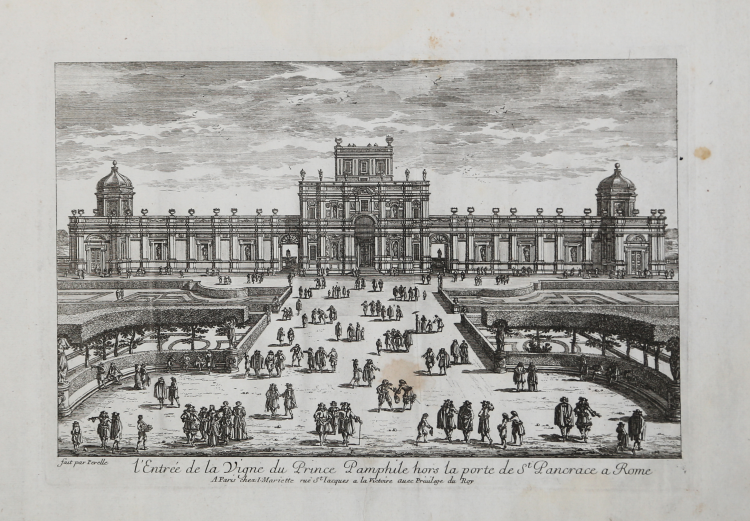



| Reference: | S9265 |
| Author | Gabriel PERELLE |
| Year: | 1650 ca. |
| Zone: | Villa Pamphili |
| Printed: | Paris |
| Measures: | 275 x 190 mm |


| Reference: | S9265 |
| Author | Gabriel PERELLE |
| Year: | 1650 ca. |
| Zone: | Villa Pamphili |
| Printed: | Paris |
| Measures: | 275 x 190 mm |
Veduta tratta dalla rara opera di Gabriel Perelle "Veües de Rome et des environs", pubblicata per la prima volta con imprint Paris: chez Mariette e contenente 20 tavole, non tuttte dedicate a Roma e dintorni.
Gabriel Perelle era allievo di Daniel Rabel e collaboratore del pittore Simon Vouet.
"Il s'inspira dans ses compositions de Claude Lorrain, de Francisque Millet, mais il conserva une facture personnelle, qui fait reconnaître ses estampes à première vue" (Bénézit).
Incisione in rame, con margini, in ottimo stato di conservazione.
Gabriel PERELLE (Vernon-sur-Seine 1604 – Parigi 1677)
|
Gabriel Perelle was a draftsman and printmaker of topographic views and landscapes. He founded an etching workshop and, with his sons Adrien and Adam and his pupils, produced approximately 1,500 prints of a markedly uniform style. Another son, Nicolas, was a painter who worked under Simon Vouet, and also etched.
The biographical details of Gabriel Perelle's life are not well known. His ability to draw was recognized early and he was sent to study with Daniel Rabel, court artist to Louis XIII. By 1635 he had taken up etching, following the Netherlandish landscape painter-etchers whose style was derived from that of Paul Bril and Roeland Savery. Between 1645 and 1657, one of Perelle's most important commissions was to participate in the production of etchings representing the military conquests of Louis XIII. His prints depicting monuments and sites in and around Paris and Rome were mostly based on his own drawings, but he also worked after other artists, such as Laurent de La Hyre and Israel Silvestre. Gabriel Perelle had a vigorous etching style often accented with burin work. In addition to his accurate topographic renditions, he specialized in dramatic landscapes and seascapes affected by harsh weather conditions. Prints by the Perelle family were published by Leblond and others. Highly favored and collected, they were reprinted well into the eighteenth century. Gabriel Perelle was awarded the titles of printmaker to the king and engineer to the king. Around 1665 he seems to have foregone printmaking to devote himself to his duties as engineer, producing cartographic drawings and plans for Louis XIV.
|
Gabriel PERELLE (Vernon-sur-Seine 1604 – Parigi 1677)
|
Gabriel Perelle was a draftsman and printmaker of topographic views and landscapes. He founded an etching workshop and, with his sons Adrien and Adam and his pupils, produced approximately 1,500 prints of a markedly uniform style. Another son, Nicolas, was a painter who worked under Simon Vouet, and also etched.
The biographical details of Gabriel Perelle's life are not well known. His ability to draw was recognized early and he was sent to study with Daniel Rabel, court artist to Louis XIII. By 1635 he had taken up etching, following the Netherlandish landscape painter-etchers whose style was derived from that of Paul Bril and Roeland Savery. Between 1645 and 1657, one of Perelle's most important commissions was to participate in the production of etchings representing the military conquests of Louis XIII. His prints depicting monuments and sites in and around Paris and Rome were mostly based on his own drawings, but he also worked after other artists, such as Laurent de La Hyre and Israel Silvestre. Gabriel Perelle had a vigorous etching style often accented with burin work. In addition to his accurate topographic renditions, he specialized in dramatic landscapes and seascapes affected by harsh weather conditions. Prints by the Perelle family were published by Leblond and others. Highly favored and collected, they were reprinted well into the eighteenth century. Gabriel Perelle was awarded the titles of printmaker to the king and engineer to the king. Around 1665 he seems to have foregone printmaking to devote himself to his duties as engineer, producing cartographic drawings and plans for Louis XIV.
|